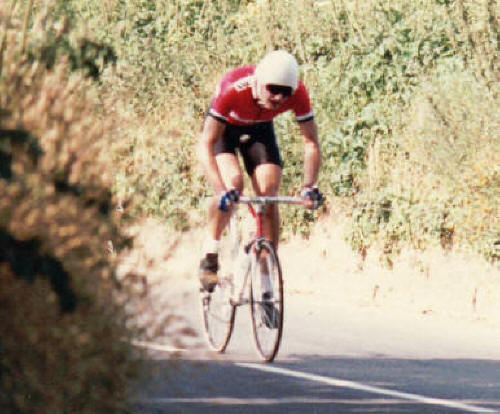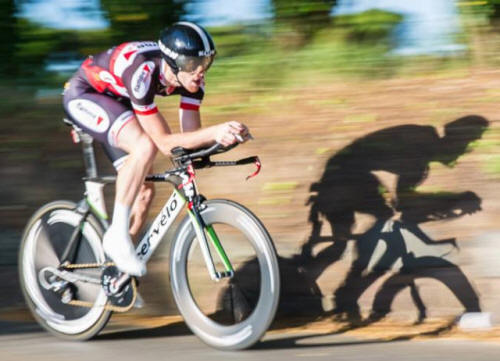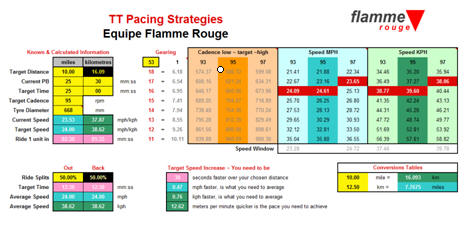Time Trial Starting Strategy

Me back in the day ~ 1986
Orbit 24" Front Wheeled Lo Pro TT Machine
As you can see, it's been a while since I did a time trial. In fact my last one was in October 2004 in the two-stage RiderMan event as part of the UCI Golden Bike Series. I'm a sociable creature, and there's no one to talk to on a TT (or draft behind) hence my reticence. Anyway, to the point...
This page should be read in conjunction with its sister factsheet, the TT PB Strategy. Combine the knowledge from the two and you're on to a winner and maybe a trophy or two.
It's a cliché, but the thing about clichés is they are normally true. "You can't win a time trial in the first mile, but you sure as heck can lose one". So here's my opinion, mixed with a few facts, on the subject of starting the race of truth.
Just because I now don't do them, doesn't mean I don't know how to do them! All it takes is a little logic, forethought, delta time application, and a bit of common sense. Here's why you should lose five seconds at the start to gain at least fifteen at the end.
 Slow,
Slow, Quick, Quick, Finish...
Slow,
Slow, Quick, Quick, Finish...
Ever see the pro's leave the ramp in a TT; even a prologue? Very slow, very measured,
very calm, very controlled and very deceiving.
Well your job is to replicate that in a way that best suits you and is commensurate with your talent pool, experience and event distance.
The shorter the event, perversely, the more controlled you have to be out of the starting gate.
People think for a short event you have to get out of the blocks as quickly and as violently as possible. Not true!
The shorter the event, the more controlled you have to be. The shorter the event, the less time available for you to recover and correct the damage you've already self-inflicted. There's your first TT myth busted!
So, during the 30 second countdown, think nice thoughts and stay calm.
Setting the Scene
The absolute cast iron best way to do this, is on a turbo trainer.
100% accuracy, available real-time telemetry, reliability of
conditions, reduced variables and increased safety.

Lee Wells ~ going through the TT paces at EFR Service Corse...
I know nearly all TT's are held outdoors (there are big, national, indoor, winter TT competitions held on Computrainer's in the US and Canada) but you may wish to hone your starting technique on the indoor rack, before taking it outdoors for fine-tuning.
In my opinion, there is no better way to prove this works, than on an indoor trainer. But for those that prefer, or have to use the great outdoors, here's how you do it.
Find a suitably flat, safe road on which you have full visibility. If you can find a course start that you use in real competition, so much the better. But above all, safety is paramount.
Go slowly up the course, or road (we haven't started yet) and find a big, immovable landmark around a mile in to the ride. Pick a house, lamp post, tree, manhole cover, grid, wall or junction. Don't pick a "red van", a flag, or a tractor/boat/caravan!
If you are using Strava, set up a segment at a start/finish landmark and maybe make it private. You don't want to give all your valuable information to the opposition!
Okay, now we have a start and a finish mapped out that we can use, over and over again. On the turbo we go for a mile, or 1600 metres. Obviously this isn't affected by wind and environmental variables and is our preferred "scientific option".
No matter how you do it, you do it on your TT bike. Always!

Andrew Derrick on the way to a new PB of 21:45
So lets get some data of our own.
Benchmarking
Before we do anything, we need to have a benchmark against which we
measure all other strategies. So you need to be fresh,
motivated, have a "weather neutral" day (science speak for not windy
or raining) and have a bike that is fit for purpose.
Get your bike's gears, brakes, and contact points checked for everything that needs to be checked to make sure it's good to go. You're about to put "race winning stress" in to your bike and yourself. Everything needs to be perfect.
Treat this as you would any of your season's key objectives, because it's that important. If you're not going to do it properly, don't bother, you'll just be wasting time and energy that can be better spent elsewhere.
The road, clothing, wheels (disc if you're using one) and time of day need to be the same as you can make it for the benchmark and all other subsequent runs. This ensures accuracy.

Dr Richard Palmer ~ Championship Winner...
Gathering Data
Get your bike in your "normal" starting gear and bring yourself to
the starting position you've chosen.
If you're doing it alone, start your timer, and let it count down to 10 or 15 seconds, before you move off.
If you're using Strava, set the segment start at a landmark and sit 10 metres or so off it when you start. We don't want any GPS "mis-fires".
When the time comes to go, go as hard as you can and get up to max ten mile TT speed as soon as you can. Ride it like you stole it and keep accelerating, to crash through the one-mile finish line with nothing left.
You should be seeing stars at the end of this effort. Do it once, then do a recovery or endurance ride, then go home!
What Now?
Well now you have a full gas
run and loads of stats. This is the fastest the "test course"
can be covered in. When we go all out, without a concern in the
world for what comes next, this is what we have. We've just done a one mile TT
and how NOT to do a start.
After a few days rest and recuperation, we go back (or climb on the turbo) and do one of your "normal" TT starts. The one you do now, the way you always do it.
Again, once completed, do a recovery/endurance ride, and get yourself home; happy with your efforts.
We now have two pieces of data against which we can compare all sorts of weird and wonderful stuff to glean valuable, PB prepping, information....
▼ Time ~ To cover the measured course
▼ Speed ~ Average, Top and Terminal (as you cross the "line")
▼ Heart Rate ~ Average, Max and a "Ramp Profile"
▼ Cadence ~ Average, Total ((avg/60) x seconds to finish), Max
▼ Perception ~ "Soft" info that influences the rest of the ride!
You can slice and dice the data any way you want to.
What we now have is an extreme start and your normal start. Now we need to find the best start. For that we obviously need a little more testing and a little more pre-preparation and information.
We need to establish your expected event Target Time. From which we will extrapolate a Delta Time, that gets us to "mile one" in the best condition possible to crack out the rest of the ride at a PB pace.
Target Time/Speed
Your target time and speed can be deduced from your overall expected
TT finishing time. If, for instance, you wanted to ride a 10 mile TT in
25 minutes dead, then you need to hit an average speed of 24.00 mph. Which translates to covering each mile in
two minutes thirty seconds.
Your objective, is to hit your mile marker in or around 2:30; bearing in mind, this is from a standing start.
If you hit it in any less, then you've gone too fast and have covered it at an unsustainable speed to meet your TT pacing objective. Covering it in a longer time isn't a bad thing, as long as you can "claw back" the "lost" time in the remaining nine miles.
Our TT Pacing Strategies and Timings Document (above) is free should you wish to have one. Just follow the link and click where appropriate...

Efficient & Effective ~ Duo Normand
Kat (left) Florence (right)
Efficiency v Effectiveness
Finally, we come to our "experimental" starts. This is where
it gets really interesting, and you might even be able to do two or
three of these in a single session, as they're not full-gas and
physiologically damaging as your previous efforts.
Start One; will be a "soft" start. A gear lower than previously used and a gentle start, slowly getting up to speed over 500 metres or so and staying below your target time/speed for the duration of the test.Start Two; will be a "medium" start. A gear lower than previously used and a steady start, getting up to speed over 250 metres or so and staying below your target time/speed for the duration of the test.
Start Three; will be a "steady" start. The gear of your initial "benchmark" start, and a steady start, getting up to speed over 500 metres or so and staying below your target time/speed for the duration of the test.
Start Four; will be a "full" start. The gear of your initial "benchmark" start, and a steady start, getting up to speed over 250 metres or so and staying below your target time/speed for the duration of the test.
Once you have this data, you can mix and match your own variations to see what works best for you. Just remember to record everything and plan it before you get on your bike. Don't just make it up on the fly and try to remember what you did when you get home!
Your objective is to find the most efficient and effective starting strategy that works for you. Effectiveness is how you get the job done; efficiency is how much effort you expend doing it. Find the best balance, and you're half-way to a PB.

Mark Shaw ~ Grand vet TT Champion
Wood v Trees
Once you have the data you need to sift through it looking for the
best gear to start in. Is it better to have a high gear and
"churn it" or start lower, keep the torque down, and change up as
you reach your cadence high point? Crunch the numbers to find
out.
How long do you stay out of the saddle for at the start? How quickly do you get aero? What is your maximum power output during the first 30 seconds? What heart rate profile are you looking to achieve? At what point do you get to the target average speed?
Lots of info to get your head around and lots of variations to try.
Don't get too sidetracked looking for esoteric solutions. All you need to do is get to the one mile marker around a tenth of the time of your expected finishing time, in the best physiological condition possible to complete the rest of the ride.
In effect you have two distinct competitions in each event. The start, and the rest of the ride. Your objective is to begin the "rest of the ride" in as good a physical condition as possible.
There's no point being in oxygen debt, lactate overload and with a heart rate bouncing off it's max within 500 metres of the start of a ten or twenty-five mile time trial! Because that ain't gonna get you a PB is it?

Do the right things in the right order, expect the right results.
Gary Legname being rewarded for his efforts
The Payback
Your job is to find your best
starting time, for the least physiological effort. Your chosen
start, or the one the data supports as being "the best solution", may be
five seconds slower than your fastest, or current time.
In our 10 mile time trial example, being five seconds slower at "mile one" means you only have to recover just 0.6 seconds per mile, for the rest of the ride, to be back in advantage. For a 25 mile TT, you're looking to recover 0.2 seconds per mile!
It's perfectly feasible to recover your "lost" five seconds by mile three of your event, then to "add" a minimum, of a second per mile over the remaining distance of the event.
So for a ten, you could be looking at a seven second improvement and for a twenty five a twenty-two seconds improvement. Without doing any training! How cool is that?
The Science
When you're looking to get PB's, doing the same thing only harder,
ain't gonna work. If it did, we'd all be in the Olympics,
because we all try hard, don't we? So stop trying hard, think
hard.
Here's a bit for the number crunchers.
To cover a mile in 2:30 (or ten miles in 25:00) requires a
53 x 16 gear to be turned at 93 rpm.
To make up your "lost" five seconds from the first mile, in the remaining nine, you need to ride just 2.39 metres per minute quicker.
Which equates to 0.09 mph or a third of a rev per minute in the 53 x 16.
How hard can that be?

Medwyn Jones winning his Club's TT Championships in fine style
The Message
I know some will be looking at this and thinking, it's all a bit
of a faff.
But tell me how else you can spend an hour, two at the most, of your time to reduce your 25 mile TT PB by 24 seconds? Because I'll tell you now, a session of 2 x 20 minutes @85% FTP ain't gonna do it!
Of course, FTP sessions need to be done, and you can't win an event just by practicing the start. But as we said earlier, you can easily lose one by not practicing it.
Find a safe road, practice different start procedures and find the best of fits for you. If you have a power meter, keep your wattage within around 150% of your TT average at the start. So if your ride average is 300 watts, try to keep below 450 as you leave the gate.
Keep your speed, lactate and heart rate under control. Think efficiency, not effectiveness.
Break your event in to two parts ~ the efficient first mile, then the effective rest of it!
Why not amuse yourself with a mate for an evening or two and have a go. What have you got to lose?
Seven seconds in a "ten" apparently! Which may bring you a National Title (or three) like Norco's, Mr Derek de Gannes (below) adding to his ever-growing collection of Trinidad and Tobago silverware...










